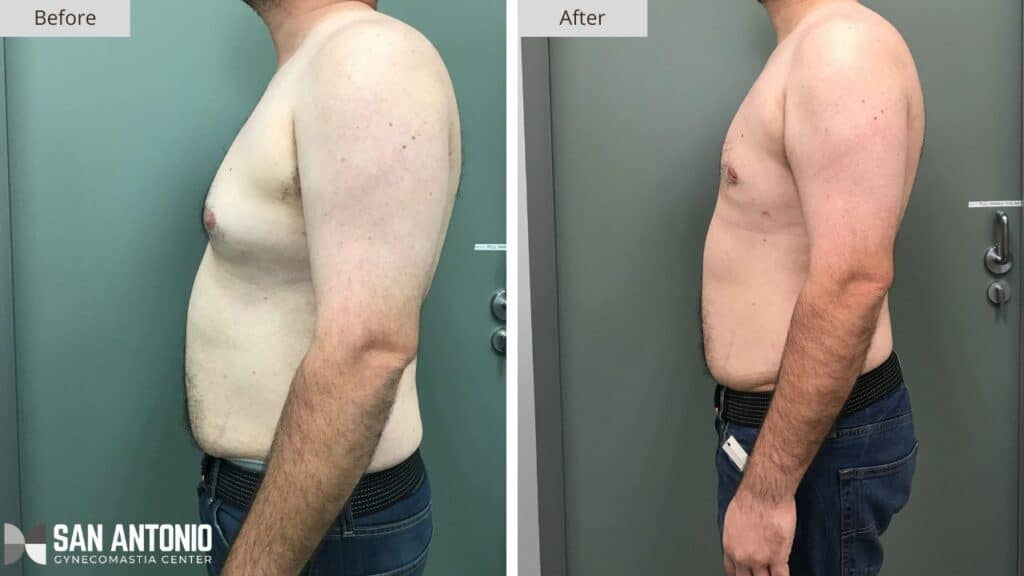Gynecomastia is caused by a variety of factors, including medical conditions, medications, substance use, aging, and several others. However, at the core of these causes is the theme of hormonal imbalance.
Fluctuations in testosterone and estrogen levels can upset the body’s balance, resulting in male breast development. Understanding this fundamental principle and the factors that contribute to it is crucial in effectively managing gynecomastia.
At the San Antonio Gynecomastia Center, we are here to help get you going in the right direction. Schedule a consultation today to meet with our doctor.
What Causes Gynecomastia?
Gynecomastia stems from an imbalance of estrogen and testosterone. This involves an excess of estrogen, a deficiency of testosterone, or a combination of both. It is important to understand this imbalance when thinking about ways to reduce gynecomastia.
Enlargement of male breast tissue, which is frequently caused by this hormonal imbalance, is the main sign of gynecomastia.
Moreover, it’s essential to understand that in numerous cases, the root cause of gynecomastia remains unknown. In such cases, hormonal imbalance may not serve as the primary cause.
It is also important to consider that man boobs can also be caused by excess adipose (fatty) tissue in the breast. This can be a standalone issue (pseudogynecomastia), or it can frequently be an issue in combination with excess breast gland tissue. If excess fat accumulation is the only problem in your chest area, true gynecomastia causes may not be the primary culprit.

Infancy and Puberty
Infant boys and adolescents entering puberty may experience transient gynecomastia.
In infants, this is attributed to residual maternal estrogen and typically resolves within a few months. For adolescents, hormonal fluctuations during puberty lead to the condition, which generally resolves within 6 months to 2 years.
Gynecomastia is common in adolescent boys. As many as 60% of teenagers will have some signs of gynecomastia by the age of 14. It is largely due to the hormonal changes we all undergo during puberty.
This is a typical phase of puberty, and the symptoms typically subside within a span of two years. However, in some instances, the symptoms of gynecomastia may persist. In these cases, surgical intervention to address the issue may be necessary.
Substance Abuse & Alcoholism
The excessive use of certain substances can lead to cases of gynecomastia. Such substances include heroin, methadone, marijuana, methamphetamine, and other members of the amphetamine family.
Another substance abuse problem that is noticeably more common than illicit drug usage is alcoholism.
Beer, in particular, plays a significant role due to its high content of phytoestrogens. These are plant-based compounds known for their estrogen-mimicking effects.
While not conclusively proven, some scientists speculate that excessive intake of phytoestrogens may result in effects similar to those induced by elevated levels of true estrogen.
Aging
As men age, there’s a gradual decline in testosterone levels. This process typically initiates around the age of 30 and persists throughout life.
Individuals over the age of 50 are especially susceptible to developing gynecomastia. It’s estimated that up to 65% of men in this age bracket may develop senior gyno.
Anabolic Steroids
Professional bodybuilders frequently experience gynecomastia due to the use of anabolic drugs.
These steroids encourage testosterone production, which in turn may cause the body to convert excess testosterone into estrogen. In many cases, this can lead to bodybuilder gynecomastia.
High Body Fat Percentage
High body fat leads to higher rates of gynecomastia in two ways: increased fat storage in the chest (increased fat issue), and higher levels of estrogen (which, in turn, make the development of breast gland tissue more likely).
Higher levels of fat also lead to a reduction of testosterone and an increase in estrogen. An enzyme called aromatase converts testosterone into estrogen.
The bulk of this conversion happens in fat tissue, and so the more fat tissue you have, the higher your estrogen levels may be.
Hypogonadism
Hypogonadism refers to a condition characterized by insufficient levels of androgens (the male hormones).
This insufficiency may result from a number of different things, such as radiation exposure, mechanical trauma, or medical disorders that harm the testes. Alternatively, it may result from impairment of the pituitary gland or hypothalamus.
Chronic Diseases
Disorders affecting the liver and kidneys, along with hyperthyroidism, have the potential to disrupt hormonal equilibrium. This can result in elevated estrogen levels and diminished androgens.
Additionally, hyperthyroidism can induce an upsurge in androgen levels, which paradoxically triggers a rise in estrogen. This occurs as the excess androgens undergo conversion by the body.
Prescription Medications
Many cases of gynecomastia can be attributed to the use of prescription medications. These include:
Consult with your doctor to determine whether the medications you are taking could potentially decrease testosterone levels or elevate estrogen production. It’s crucial to remember that even if these side effects do occur, you shouldn’t automatically stop taking your prescription. Instead, staying informed enables you to handle any possible hormonal shifts with the right actions.
Contact a San Antonio Gynecomastia Surgeon
Whether you are in San Antonio or any surrounding areas, feel free to schedule an appointment at the San Antonio Gynecomastia Center and let us help you achieve your ideal results.
Our compassionate team is here to provide personalized care and effective solutions tailored to your needs. Schedule your consultation with a San Antonio gyno surgeon and take the first step towards addressing your gynecomastia.
At the San Antonio Gynecomastia Center, we prioritize delivering exceptional care from your initial consultation to your recovery and beyond. We deeply value the trust you place in us and are committed to upholding the highest standards of patient care. Our team, led by board-certified gynecomastia plastic surgeon specialist, Dr. Michael Baumholtz, is devoted to achieving optimal outcomes for each individual. Recognizing that every person is unique, we personalize our approach to meet your specific needs. Whether you have questions or are ready to schedule your in-person or virtual consultation, please don’t hesitate to contact us today. We’re here to support you every step of the way!
San Antonio Gynecomastia Center
4083 De Zavala Rd #1A
San Antonio, TX 78249
(210) 960-8051

